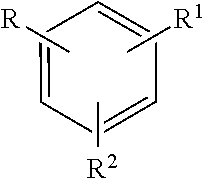Unleaded fuel compositions
a technology of unleaded fuel and composition, which is applied in the direction of fuels, machines/engines, mechanical equipment, etc., can solve the problems of increasing the probability of knocking, increasing the difficulty of production of fuels of progressively higher octane values, and increasing the difficulty of producing, so as to reduce the specific fuel consumption of brakes of engines and increase engine efficiency
- Summary
- Abstract
- Description
- Claims
- Application Information
AI Technical Summary
Benefits of technology
Problems solved by technology
Method used
Image
Examples
examples 1 to 3
[0134]A Reference blend (Reference Example) and 3 blends according to the present invention (Examples 1 to 3) were each prepared by blending the components specified in Table 1 below.
[0135]Table 1 below provides the composition of each blend, while Table 2 below shows measured properties of each blend. In Table 1, the percentage volume of each component is the percentage of the whole composition specified. In addition, each blend contained 250 ppm of anti-oxidant and 2680 ppm of detergent which was the same in each blend. The ethanol utilized in each blend is bio-ethanol obtained from cellulose-based residue from the paper industry.
[0136]
TABLE 1ExampleCompositionReference123Ethanol% v10.4202020Toluene% v22.5101034Xylene% v8.9000Total Aromatics% v31.4101034Refinery Hysomerate% v24.9000Refinery Alkylate% v33.3000Isopar E*% v0281825Iso-Octane% v025270Iso-Pentane% v01784Total Paraffins% v58.2705329Di-iso-butylene% v00702-methyl-2-butene% v001017Total Olefins% v001717Total% v100100100100...
example 4
cific Fuel Consumption (BSFC)
[0139]BSFC is the rate of fuel consumption divided by the power produced and is a measure of fuel efficiency which allows different engines to be compared directly; conversely when the engine is kept the same this measure also provides a way of comparing fuels directly.
[0140]Fuel blends corresponding to those of Examples 1 to 3, i.e. having 20% v / v of ethanol, were prepared using alkylate in place of the iso-pentane, iso-octane, and Isopar E mixture. Subsequently the same fuel blends were prepared but using a different batch of alkylate. When tested for BSFC, a variation of around 5 g / kWh (grams per kilowatt-hour) was found for blends that otherwise were the same but for the different batch of alkylate.
example 5
[0141]The fuels of Examples 1 to 3, and a Reference fuel corresponding to the Reference Example were run through a single cylinder turbocharged engine and the BSFC measured. The results are given below; the variance for each measurement is +−1 g / kWh:
[0142]
TABLE 3Reference123BSFC228230225227
Discussion
[0143]These results demonstrate that despite doubling the ethanol content, comparable BSFC is achievable, with the best results (i.e. the lower BSFC) being given by the fuels having an olefin content.
PUM
| Property | Measurement | Unit |
|---|---|---|
| volume % | aaaaa | aaaaa |
| volume % | aaaaa | aaaaa |
| volume % | aaaaa | aaaaa |
Abstract
Description
Claims
Application Information
 Login to View More
Login to View More - R&D
- Intellectual Property
- Life Sciences
- Materials
- Tech Scout
- Unparalleled Data Quality
- Higher Quality Content
- 60% Fewer Hallucinations
Browse by: Latest US Patents, China's latest patents, Technical Efficacy Thesaurus, Application Domain, Technology Topic, Popular Technical Reports.
© 2025 PatSnap. All rights reserved.Legal|Privacy policy|Modern Slavery Act Transparency Statement|Sitemap|About US| Contact US: help@patsnap.com


